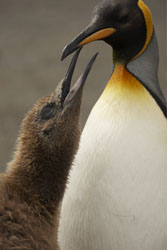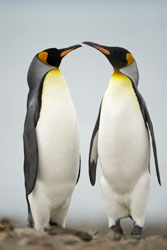

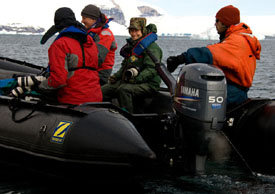 We started 2008 in a grand style, flying south
to Ushaia, Argentina, the southernmost city in the world where
we would join Joe Van Os, and several other photographers and
naturalists to co-lead Joe's Ultimate Antarctica Photo Tour. For
over three weeks we sailed through the southern ocean, visiting
the Falkland Islands, South Georgia (the island of), and the Antarctica
peninsula. This was the second time for us helping with a Van
Os trip, and like our first experience two years ago, it was a
blast, good fun, and photographically, extremely productive. This
year's trip was scheduled approximately one month earlier than
our preceeding trip, and the activity with the birds and the seals
reflected this. Whereas we saw few Adelie penguins on our first
trip, this time we did some of our most exciting work with this
tuxedo-clad small penguin. In all we saw and photographed seven
species of penguin - king, macaroni, Adelie, chinstrap, gentoo,
Magellanic, rock-hopper; two albatross species, four true seals
- Weddell's, leopard, crab-eater, and elephant; Antarctic fur
seals (the eared seals), and humpback and orca whales.
We started 2008 in a grand style, flying south
to Ushaia, Argentina, the southernmost city in the world where
we would join Joe Van Os, and several other photographers and
naturalists to co-lead Joe's Ultimate Antarctica Photo Tour. For
over three weeks we sailed through the southern ocean, visiting
the Falkland Islands, South Georgia (the island of), and the Antarctica
peninsula. This was the second time for us helping with a Van
Os trip, and like our first experience two years ago, it was a
blast, good fun, and photographically, extremely productive. This
year's trip was scheduled approximately one month earlier than
our preceeding trip, and the activity with the birds and the seals
reflected this. Whereas we saw few Adelie penguins on our first
trip, this time we did some of our most exciting work with this
tuxedo-clad small penguin. In all we saw and photographed seven
species of penguin - king, macaroni, Adelie, chinstrap, gentoo,
Magellanic, rock-hopper; two albatross species, four true seals
- Weddell's, leopard, crab-eater, and elephant; Antarctic fur
seals (the eared seals), and humpback and orca whales.
In late November-early December of 2009, Joe Van Os is planning on doing another Ultimate Antarctica trip, and we'll again be joining Joe as two of the leaders. That trip will perhaps be the best of all for penguin photography, since the birds will be on eggs, perhaps on snow, and will be clean, active stone-stealling nesters, and the seal activity will be at its peak. We can't wait.
On this year's trip I kept a daily journal, which I've reprinted here to best tell the Antarctic story. On some days the journal was rather brief, especially if we made two landings or did a full day, but the images help tell the story that my words did not. The illustrations are a mix of Mary's and my shots -- you can guess that Mary's are the ones you'll like best!
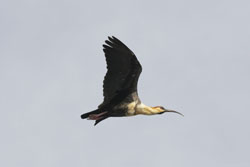 Day One
- Depart Ushuaia without incident, with Beagle Channel smooth
and calm. Left around 4PM, with pilot boat leaving us around 9:30PM.
En route, Peale's dolphins bow-rode and then, another group, did
some great leaping. John Shaw caught it - tiny, but blown up it
still looked good.
Day One
- Depart Ushuaia without incident, with Beagle Channel smooth
and calm. Left around 4PM, with pilot boat leaving us around 9:30PM.
En route, Peale's dolphins bow-rode and then, another group, did
some great leaping. John Shaw caught it - tiny, but blown up it
still looked good.
Day Two - Our cabins were almost unbearably warm, and
after breakfast, as I got gear ready to photo the seabirds following
the boat, I threw up - the first time ever from sea-sickness.
I lost much of the morning, having no juice in me, but got some
cape pigeons and giant petrels bow-riding, and eventually the
sea calmed, whereupon the birds disappeared. A buff-necked ibis
joined the boat and eventually departed at New Island.
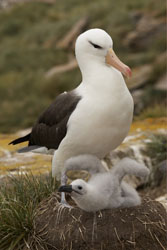
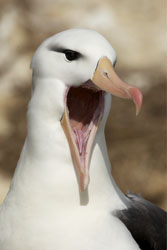
Day 3
- New Island, Tony Chatter's side. About a 1 mile walk got us
to a nice black-browed albatross and rock-hopper colony, much,
much better than the last one we'd visited on New Island two years
ago. A very tolerant striated caracara nested below a bluff, and
full-frame chicks (almost full-grown) and adults, plus some King
cormorants. I got a black-faced tyrant in flight, and some good
Magellanic penguins, too. We started the visit by volunteering
for the first shore-duty shift, but since everyone headed to the
colony - about a half mile walk, we had the nearby hillsides to
ourselves and a few others. The colony was sweeping, and the cliffs
dramatic, and New Island, at least here, offers very impressive
views.
We were scheduled to visit the NI settlement in the evening, but
by 6PM it had clouded over and later began to rain. Since we wouldn't
land until 8, after dinner, and it was dark, rainy, and we had
had a very successful day, we passed on another landing and relaxed.
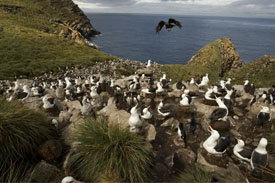 Day 4
West Point Island and Carcass Island - A heavy fog lay over the
top of WPI, threatening to shroud the BB Albatross colony, and
several of us were more than happy to do shore duty and shoot
the bird life around shore and at the settlement. I volunteered
to go to the colony - about a 1.5 mile walk, but luckily Anna
and I got a ride up so that we could direct traffic. The colony
was small, and the trails, a loop and one-way route, brought everyone
very close to the albatrosses and rock-hoppers. I saw more grass
wrens here than I've ever seen in the FI, and managed some close-ups.
After a bit folks wandered off the established trail and to the
back-end of the colony, but the owners didn't mind, so we got
some new perspectives. Mary worked shore duty and got some great
geese and ducks.
Day 4
West Point Island and Carcass Island - A heavy fog lay over the
top of WPI, threatening to shroud the BB Albatross colony, and
several of us were more than happy to do shore duty and shoot
the bird life around shore and at the settlement. I volunteered
to go to the colony - about a 1.5 mile walk, but luckily Anna
and I got a ride up so that we could direct traffic. The colony
was small, and the trails, a loop and one-way route, brought everyone
very close to the albatrosses and rock-hoppers. I saw more grass
wrens here than I've ever seen in the FI, and managed some close-ups.
After a bit folks wandered off the established trail and to the
back-end of the colony, but the owners didn't mind, so we got
some new perspectives. Mary worked shore duty and got some great
geese and ducks.
The owners of WPI told us we probably wouldn't land on Carcass,
as a big front and gale-force winds was forecasted. At 3PM, as
we mustered to load the zodiacs, the black clouds to our south
looked pretty ominous, and as we waited to board a wind picked
up, increasing steadily. Within a short time it was gusting over
20 knots, and wisely Chris, the expedition leader, cancelled the
excursion. In the next few hours the wind increased to gale force,
making for a somewhat rocky trip over to Saunders.
Later that afternoon Chris had to make two zodiac trips to shore
with our passports to get cleared with customs, a very harrowing
journey.
Day 5 - Saunders Island. Because of the wind we anchored
on the north side of the neck, the ocean side, but even with much
of Saunders and the neck breaking the wind's force we still had
whitecaps. We had steady 30 knot winds, gusting to over 40, and
even 45 knots, so we abandoned the attempt and began a rather
rocky journey toward South Georgia, a three day sail.
En route, two large swells hit the boat within seconds, and people's
dresser drawers, chairs, and various items were tossed to the
floor. As were people, especially in the lounge, where one lady
busted her lip and banged her head, and many were rocketed out
of their seats - which were gliding across the lounge floor.
In the cabins it was worse. One passenger got tossed and put her
head through the drywall, as well as bruising her shoulder and
arm. Another banged and bruised his shoulder, and it was feared
he might have torn his rotator cuff in his shoulder, but he seems,
two days later, to be recovering nicely. A shiner on his right
eye still testifies to his ordeal.
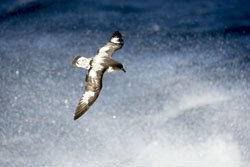 Day 6
- At sea. Heavy seas marked the early part of the day, making
deckside shooting rather difficult. By late afternoon the wind
had settled and the seas smoothed, but there still was enough
wind for a few wandering albatrosses and giant petrels to be flying
about.
Day 6
- At sea. Heavy seas marked the early part of the day, making
deckside shooting rather difficult. By late afternoon the wind
had settled and the seas smoothed, but there still was enough
wind for a few wandering albatrosses and giant petrels to be flying
about.
Day 7 - At sea. A heavy fog created low visibility
and a low ceiling, and with rather light winds relatively few
birds were in the air. This afternoon a good part of the time
was spent vacuuming clothes and packs for errant seeds that might
contaminate the islands, which we hope to land on tomorrow.
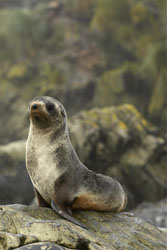 Day 8,
January 14, 2007 South Georgia, Elsehul and Salisbury Plains
Day 8,
January 14, 2007 South Georgia, Elsehul and Salisbury Plains
The day began foggy and unpromising, but we hoped that the abundant
Antarctic fur seals that are so abundant on the beaches of Elsehul
would allow us to land. Our original plan was to do a short shore
visit, followed by a zodiac cruise along the shoreline, but upon
landing on Elsehul we found the shooting rather rewarding. Elsehul
is characterized by three species of penguins and three albatross
species, and we saw two of each - a small number of gentoos and
a cluster of king penguins, and black-browed and gray-headed sooty
albatrosses lined the cliffs and slopes that surrounded the bay.
Fur seals characterized our visit, with numerous babies and multiple
harems, but the beach masters were more concerned with rounding
up errant cows than in bothering us. Our visit lasted about two
hours, in time that just rushed by.
As we motored to the Salisbury Plains we had lunch, and while
we dined the fog that characterized most of the morning at Elsehul
began to break, with patches of blue sky and shining patches of
island and ice promising sunny skies. By the time we anchored
and began disembarking, the weather and seas were about as good
as one could hope for in South Georgia, although that would change
by day's end.
Our visit to Salisbury Plains was extremely productive, with thousands
of penguins lining the beach, punctuated here and there by small
groups of seals, and accented by kelp gulls, Antarctic terns,
and skuas flying low over the surf. The tens of thousands of king
penguins and their mollywog, brown-coated nearly full-grown chicks
that cluster at the breeding colony, a congregation of birds that
creeps up the tussock grass-covered slopes like an avian river,
is unforgettable. As expected, as we sat or stood and watched,
curious full-grown chicks marched up to us, sometimes pecking
at a boot or tripod leg before ambling off.
By 5:30 a low fog that had wreathed the mountain ridges began
blowing in hard, and with it winds that grew to greater than 30
knots. Our calm beach was transformed into a rolling surf, and
fighting the zodiacs to shore, and loading people and gear, offered
a final challenge for the day.
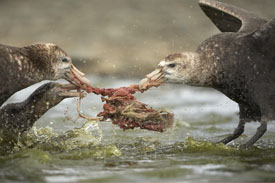
Day 9
Salisbury Plains and Fortuna Bay
The day started with a 5:00AM breakfast, but the light was bad
and we went back to bed for a 7-ish departure for the plains.
It was windy, and after a fairly good afternoon at the colony
I headed east along the beach, eventually arriving at a pond where
the wind had pushed the carcasses of seals. Giant petrels were
actively feeding and fighting, and running grandly across the
water to take off.
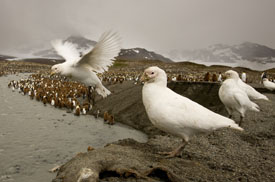



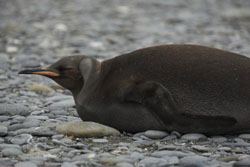
 Day
10 Saint Andrews Bay
Day
10 Saint Andrews Bay
5:00 breakfast, but again bad weather held us back until 7:30,
but Mary and I stayed out all day, catching the last zodiac after
6PM. Awesome. Spectacular. Breath-taking. The plains and meandering
glacial rivers of this plain makes the Salisbury Plains look puny
in comparision. The colony borders a fast-moving stream that is
bordered by a few low hills, making great overlooks of the colony.
My favorite shots of the day were of snowy sheathbills and skuas,
both of which I shot with wide-angle closeup, with the masses
of king penguins as a backdrop.
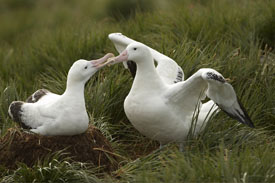 Day 11
Salisbury Plains and Prion Island
Day 11
Salisbury Plains and Prion Island
Had a 7:30 breakfast and departed around 8:45, with no wind, heavy
clouds, and relatively low light. Some folks did wonderfully with
penguins coming to shore quite close to our landing spot, but
I wasn't motivated and instead spent time filming skulls and skeletons
of dead seals, a whale vertebrae, and a bunch of seals.
In the afternoon nearly half the participants stayed on board
when we landed on Prion Island for wandering albatrosses. Joe
Van Os painted a realistic picture of the conditions, especially
based upon our last trip 2 years ago, so a lot of folks were disinclined
to go. The weather was drizzly and windless, and didn't look promising.
However, the weather improved and by day's end we had diffused
sun, and several nests, and several times birds moving about came
within frame-filling distance of our 500mm's. Two people got nice
shot South Georgia pipets, the most southernly songbird, too.
All told, a great afternoon, making our last trip a nightmarish
memory.
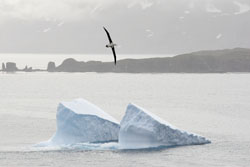
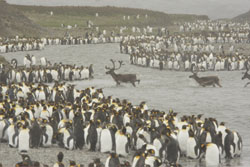
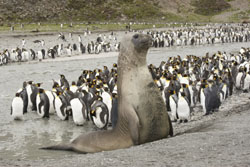
 Day 12
Gryveken and Saint Andrews Bay
Day 12
Gryveken and Saint Andrews Bay
A cold and snowy morning marked arrival at G, and I didn't think
I'd be very motivated to shoot more ruins and relics from the
whaling days, but I was surprised. I looked for symbolism, the
old and the new, and whether I was successful or not I had a lot
of fun. Mary had everyone meet John Fowler, our old friend from
the Falklands, by name. John is now the assistant manager of the
gift shop, and the three of us had a nice tea-time talking about
old times. A toast to Shackleton finished our morning - I climbed
the hill to do an aerial of the toast.
It was cold and dreary, and grew increasing duller when we landed
at Saint Andrews Bay, and for a time the elephant seal that performed
so well for Christine again did so, but by the time I could get
my gear ready it was finished. Got some ok shots of king penguins
amongst the elephant seals, and seals playing and running. A small
herd of reindeer grazed just across the stream, but they weren't
too inspiring. As the afternoon progressed the seas grew rougher,
and our sand spit, where we had stored our gear, began to get
waves washing over the lower end. Mary, Chris, and I were at the
beach when the first group loaded a zodiac to return to the boat,
but a wave beached the zodiac and it took a few extra people,
leaving the boat, to push it back into the water. That was the
easy part. The next two zodiacs experienced increasingly difficult
launchings, but by the fourth or fifth the other guides had joined
us, and together we fought to launch the boats. It was tough,
and demanding, and Chris Edwards, particularly, was beaten and
soaked by the waves. Many of the guides only had hip-waders, and
almost all had very wet legs by the end. It was punishing, physically,
but aside from the risk of flipping a zodiac that angled in wrong,
or breaking a leg or wrenching a knee hitting one of us as it
surged to shore, it wasn't that bad. Except none of us wanted
to repeat that again! The landing at the boat surged two meters
or so, and zodiacs banged about, making getting back onto the
boat a challenge.
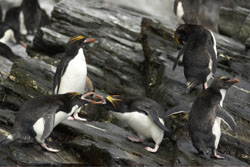
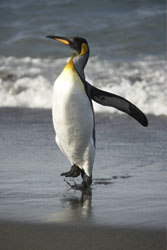
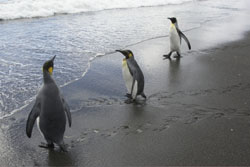
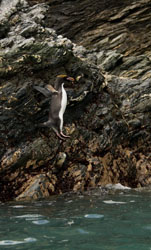 Day 13
Gold Harbor
Day 13
Gold Harbor
Increasingly powerful winds created a surging boat, making getting
on to the zodiacs a challenge. The crew felt a landing wouldn't
be too difficult, but afternoon yesterday's fight on the beach
I wasn't looking forward to it. At any rate, we cancelled the
Gold Harbor shore landing as the winds increased to 30 knots and
the seas got increasingly rough.
Later that morning we cruised a macaroni penguin colony along
southern part of Royal Bay. Mary and I did two zodiac runs, with
the first very rough, cloudy, and bumpy. Mary's zodiac was almost
swept into shore - a real dilemma if that had happened, but she
had a blast. The second zodiac ride was fairly smooth in comparison,
and everyone did pretty well.
In the afternoon we landed near Ross Glacier, in Little Moltke
Harbor, where king penguins were moulting and a huge glacial face
and stranded small bergs marked the afternoon. I tried several
4-8 second exposures with the Singh-Ray variable neutral density
filter - probably the best stuff I shot that afternoon.
Day 14 Cooper Bay
This morning was probably one of the best weather days we've ever
had at South Georgia, being long-sleeve shirt weather and sunny,
and, without a wind, we were able to zodiac in to an easy landing
at Cooper Bay for a macaroni penguin colony. These penguins nest
on steep, tussock-covered hillsides, and initially the shooting
was pretty iffy, with a lot of vegetation screening birds, most
of which were muddy. Later, a few of us circled high, avoiding
hidden fur seals, and got onto the sun-lit side of the colony
and a much more open view, for some good shots. Several participants
had great, clear view of birds with chicks - better than I had
from a much more difficult position, so pretty successful day.
In the afternoon we cruised up the 11 mile long Drygalski Fjord,
in catabatic winds that reached hurricane force of 70mph. It was
fun walking into the wind, 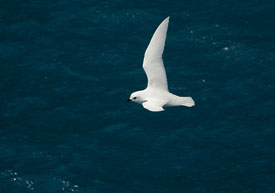 especially
at spots along the ship that formed a wind tunnel, giving us the
chance to experience what a small hurricane-force wind would be
like. A few snow petrels unexpected appeared, along with cape
petrels, and I got both.
especially
at spots along the ship that formed a wind tunnel, giving us the
chance to experience what a small hurricane-force wind would be
like. A few snow petrels unexpected appeared, along with cape
petrels, and I got both.
In the late afternoon we headed south, leaving South Georgia.
En route, a weird low-hanging rainbow arched across the eastern
horizon, at times framing icebergs. As night settled, we're heading
through a maze of tabular iceberg, some probably 20 miles long,
with a sea filled with small bergs. Most of the officers of the
boat are on deck, and they, and we, are hoping that are passage
- now detoured somewhat because of these huge bergs, won't be
blocked off and we'll be forced to retrace our steps. Scary in
a way, because if a ship would get cut off, and these mammoth
mountains of ice would drift together, they'd squash a ship like
a bug! To date, that hasn't happened … so let's hope we don't
set a precedent.
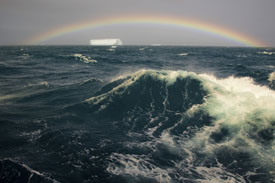 Day 15
At Sea to the South Orkneys
Day 15
At Sea to the South Orkneys
A day of lectures on the boat, and after the first one, where
I froze in the lecture room and still managed to fall asleep through
much of it, I decided to recoup and spent most of the rest of
the day either sleeping or reading. I really needed to recharge.
 Day 16
At Sea
Day 16
At Sea
Our arrival into the tabular icebergs of the Orkneys was delayed
because of sea ice and fog, and when we arrived - which should
have been a dawn shoot of magical icebergs, we were greeted by
a pea soup fog. Rather than waste time, we continued on toward
Paulet Island for Adelie penguins.
Day 17 Cruising into the Antarctic Sound toward Paulet
Island
We had close to perfect weather as we cruised into the iceberg
and ice strewn Antarctic Sound, encountering a very curious trio
of humpback whales that approached the boat several times and
made for great shooting. Later, at a greater distance, we saw
the distinctive dorsal fin of a Minke whale, and later still,
as we began to encounter penguins on ice flows and porpoising
through the water, we saw three or four orcas. One of these seemed
to hover in the water, motionless, and we were hoping, at the
penguins' expense, that it would pursue one of the many groups
of penguins that raced through the flows. Everyone shot a lot
of images - the weather was almost cloudless, until late in the
day when another fog set in.
We arrived at Paulet just before dinner and anchored very close
to shore. A large flat berg covered with Adelies floated just
off shore, and after dinner, whether because the boat drifted
closer or the iceberg did, we were close enough for nice 500mm
shots of the penguins, many of which obliged by diving in. Later
it cooled and snow flurries obscured the island, and we hoped
that the colony would get a nice coating for the next day's shoot.
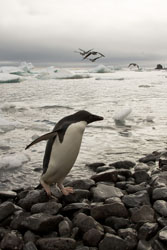 Day 18
Paulet Island AM
Day 18
Paulet Island AM
A 5AM breakfast and a 6:00AM departure for the island, under somewhat
dreary skies. Penguin chicks were crèched everywhere, and
there was a tremendous amount of activity, both on the shoreline
and at the colony. Blue-eyed shags nest on the island also, and
periodically during the morning masses of birds would leave the
colony and sweep down the shoreline. I was facing the sun (which
was mostly obscured) so I didn't have good light for flight shots,
but tried some with my wide-angle and flash as they swooped by.
I had a bit more luck sitting at the shoreline with my 16-35,
catching penguins along the shoreline and the sweep of grounded
icebergs and leaden sky in the background.
Goughlet (Gaughin?) Island PM
We cruised back through the Antarctic Sound, leaving Paulet for
a 5 hour trip to G Island. En route we had the most spectacular
weather - no breeze, no clouds, virtually ripple-less seas, and
tabular icebergs and huge floes everywhere. If anything, the scene
seemed even more spectacular than yesterday when we cruised into
the Sound.
G Island had not been visited by anyone in our crew before, but
three species of penguin nest here. It turned out to be a spectacular
site and sight, with massive Adelie colonies on the hillsides
and small peninsula-like projections filled with clusters of tightly
bunched Adelies waiting to dive into the surf. A lone leopard
seal patrolled the coastline, perhaps the reason for the penguin's
bunching.
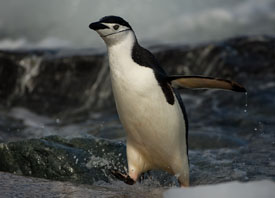 The day started relatively warm and cloudless,
and most of the group migrated to a viewing area where we could
shoot penguins gathered in these shoreline clusters. At times
scores of penguins would porpoise in to the rocks, making for
a great show albeit a challenging photograph. There was a lot
of opportunity for filming Adelies feeding chicks, often against
a clear sky or a very distant mountain backdrop, so clean backgrounds
were easy.
The day started relatively warm and cloudless,
and most of the group migrated to a viewing area where we could
shoot penguins gathered in these shoreline clusters. At times
scores of penguins would porpoise in to the rocks, making for
a great show albeit a challenging photograph. There was a lot
of opportunity for filming Adelies feeding chicks, often against
a clear sky or a very distant mountain backdrop, so clean backgrounds
were easy.
While we shot, a sea fog gathered in the west which eventually
bathed the island in a softer light, and heralded high winds.
We had landed at low tide on an easy rocky beach, but we left
in a rising tide buttressed by the winds. It made for an interesting
departure, but not nearly as challenging or physically taxing
as those we had had on South Georgia. The temperature plummeted,
too, just showing how variable, and how fast, the weather down
here change.
 Day 19
Ronge' and George's Point and Neco Harbor
Day 19
Ronge' and George's Point and Neco Harbor
Clear skies and ideal temperatures marked our landing at Ronge'
at George's Point, and within minutes of our arrival on the island
six humpback whales appeared, eventually swimming quite close
to shore. For those hardy enough to get up early, the light at
5AM, about one half hour after sunrise, was soft and exquisite,
and the air cold, so much so that the the standing water on the
deck froze within minutes. Great glacial views and spectacular
scenery defines George's Point, making great backdrops for the
colonies of gentoo and chin-strap penguins. Many of the good gentoo
penguin nests were fairly close, and many of the chicks and adults
were clean-feathered, in contrast to the rather guano/krill stained
coats of the chin-strap penguins that nested higher up on the
slopes and isolated pinnacles.
When the humpbacks appeared zodiacs were launched in hopes of
up close and personal whale photography, but the whales showed
no curiosity and continued out to sea. All wasn't lost, however,
because the zodiacs rides along the huge icebergs stranded in
the bay made for spectacular shooting.
Along the beach a lone, extremely somnolent Weddel's seal offered
good views but little in the way of action. In fact, many people
passed by not even noticing the sleeping seal. In the afternoon
we had another, slightly more animated Weddel's seal at Neco Harbor,
which, surrounded by gentoos, made for some interesting shots.
Our arrival on the Antarctic mainland at Neco Harbor was, appropriately,
marked by a light snow, giving everyone a true sense of the South.
Remarkably, shortly after everyone came ashore another pair of
humpback whales appeared, cruising quite close to shore. With
stranded mini-bergs, gentoo penguins, and knock-out scenery there
was plenty to shoot, so everyone's attention was diverted from
the sea when a humpback did a full breach, arching out of the
sea and crashing back, a splash that drew everyone's attention
a few milliseconds too late.
Neco Harbor's glacier face is simply awesome, and either as the
subject or the background for intimate shots of gentoo penguins
nesting and feeding chicks, or stranded icebergs along the shoreline,
the photography was incredible.
The day ended with the famous Antarctic barbeque and Margie's
birthday, celebrated In the lounge with a sinfully rich chocolate
concoction while, through the windows, glaciers and icebergs passed
by as we motored south towards Paradise Bay.
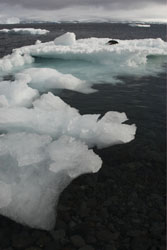
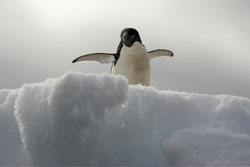
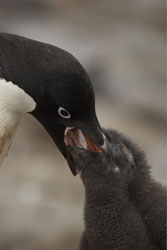
Day 20
Lamiare Channel, Pleneau Bay, Jugla Point and Port Lockroy
The day started early - Mary got up at 4AM to check the skies,
but it was overcast and didn't look promising and came back to
bed. I couldn't sleep, so I got up at 4:30 and carried outdoor
clothes and gear up in hopes that the light would break and we'd
have sweet light over the mountains in the L channel. It never
happened, and we all just hung out in the lounge watching as the
magic hour of light came and went.
Breakfast was at 6AM, and at 7AM we did zodiac cruises through
the impressive and strikingly beautiful iceberg bay at Pleneau.
On my first of two zodiac cruises we encountered a very curious
leopard seal which swam to, and under, our zodiac several times.
Joe V's zodiac had even better luck - the seal reared up out of
the water (Joe caught the shot) and then started chewing on the
zodiac. Crab-eater seals were far less common than two years ago,
although we did see four or five, but the shooting was rather
mundane. The icebergs were anything but, with designs, swirls,
and shades of white and blue - one must see it to appreciate it,
and I couldn't help but think that if global warming continued
this ethereal beauty could be lost, a sublime heritage that would
take ages to replicate.
Wind and rain conspired to dissuade a second late morning stop,
our last chance for Adelie's, so we headed up the Lamiare Channel
towards Port Lockroy. Mayr and I switched duties part way through
the shift - I spent the first half of our afternoon landing at
Port Lockroy, which features a small museum and gift shop and
a gentoo penguin colony. The caretakers wanted everyone to stay
in the immediate vicinity of the settlement , as the colony had
suffered hard this year from skua predation and from unusually
heavy rains, so the shooting was limited.
The latter part of the afternoon I spent at Jugla Point, where
scattered colonies of gentoos and a few blue-eyed shags occupy
the rocks. A partially reconstructed whale skeleton and several
piles of whale bones offer some shooting, as well as the gentoos,
but this site had to take the prize for the dirtiest and muckiest
shooting site, and with relatively filthy birds. I found one pair
still tending an egg - probably infertile, and if not, destined
for doom as a chick could never grow quickly enough to escape
winter, and one of the adults continued to gather stones, or attempt
to steal other stones from other nests, which provided some good
close-ups. By 5PM it was raining steadily and very wet I returned
with the last passengers to the ship.
That evening we had an open bar for the passengers - a loud, good
time.
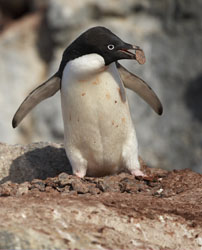 Day 21
Half Moon Bay and Haitcho Island PM
Day 21
Half Moon Bay and Haitcho Island PM
Our last full day on the Antarctica Peninsula, and fairly successful.
Half Moon Bay has a large chinstrap colony, and by climbing nearly
to the top of the island - the areas that were permissible, I
managed to get feeding shots of some reasonably clean chicks.
Our last stop, Haitcho, was a bit anticlimactic. It was raining
and a bit windy, and in truth I think most of the leaders were
tired and burned out, but the landing was easy and the shooting
- of chinstraps and gentoos, was quite good for the first part
of the afternoon session. Later, toward our 'last zodiac' call
at 7PM it got sea-misty, cold, and windy, and I was cold enough
to put handwarmers in my gloves - the first time I did that on
the trip, although had I remembered to, I may have done so earlier.
Day 22 At Sea
Rather uneventful, with some fearsome swells and rocking conditions
for much of the day, knocking cutlery to the floor and some passengers
into swaying tables.
Day 23 At Sea to Ushuaia
The second day of the much feared Drake Passage was a piece of
cake - hardly a wave or swell, and almost birdless skies. We made
great time, arriving at the head of the channel before dinner,
where we had to anchor for the night. With a calm boat, we had
a great last evening party.
Day 24 Ushuaia
6:30 breakfast, clearing the boat at 7AM, and we were all off
the boat by around 8:30. Trip ends.
